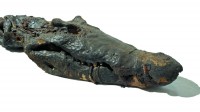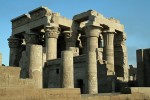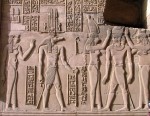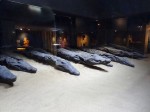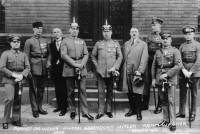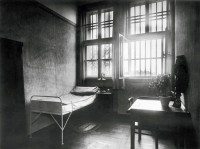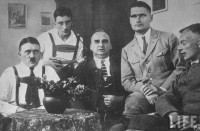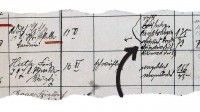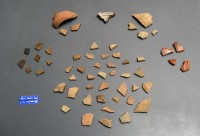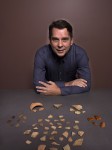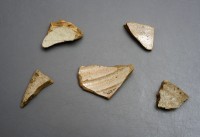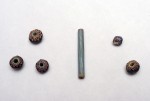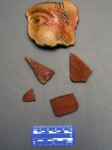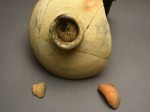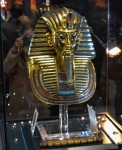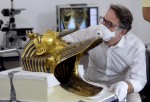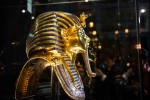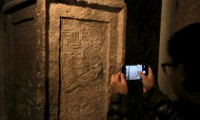 The tomb of Pharoah Tutankhamun’s wet nurse Maia was opened to journalists Sunday for the first time since it was discovered in 1996. It will be opened to the public next month. The rock-cut tomb is in the necropolis of Saqqara, about 13 miles south of Cairo, and was discovered by French archaeologist Alain Zivie in 1996.
The tomb of Pharoah Tutankhamun’s wet nurse Maia was opened to journalists Sunday for the first time since it was discovered in 1996. It will be opened to the public next month. The rock-cut tomb is in the necropolis of Saqqara, about 13 miles south of Cairo, and was discovered by French archaeologist Alain Zivie in 1996.
The tomb consists of the cult chambers with three decorated rooms and the underground, mostly undecorated, burial chambers. The first room of the cult chapel of her tomb is dedicated to the life of Maia.
She was the wet nurse of the king, educator of the god’s body and the great one of the hareem. Nothing is known about her parents. Tutankhamun is depicted on one of the tomb’s reliefs featuring the boy king sitting on Maia’s lap and the king is mentioned several times in the tomb’s inscriptions.
There is also a badly damaged scene showing Maia in front of the king. The second room is dedicated to the burial rites associated with Maia. Maia is shown in front of offering bearers. She is depicted as a mummy in relation to the opening of the mouth ritual and she is standing before the underworld god Osiris.
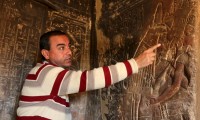 This large and elaborately decorated tomb could be an indication that Maia was not just an important figure because she nourished the young king, but because she herself was a member of the royal family. Recently an ostracon was found in the tomb that titles Maia “Mistress of Women,” a significantly higher title than wet nurse, even when the nursee is a future pharaoh. Zivie believes the depictions of Maia on the reliefs share “the same chin, the eyes, the family traits” of Tutankhamun. The tomb of Akhenaten, Tutankhamun’s father, in Tel el-Amarna has a wall carving showing the burial of Maketaten, second daughter of Akhenaten and Nefertiti, which is attended by a woman breast-feeding a baby. She is identified as Meritaten, the eldest daughter of Akhenaten, and the baby’s she’s feeding may be Tutankhamun. If true, that would make Tutankhamun’s wet-nurse his sister or half-sister.
This large and elaborately decorated tomb could be an indication that Maia was not just an important figure because she nourished the young king, but because she herself was a member of the royal family. Recently an ostracon was found in the tomb that titles Maia “Mistress of Women,” a significantly higher title than wet nurse, even when the nursee is a future pharaoh. Zivie believes the depictions of Maia on the reliefs share “the same chin, the eyes, the family traits” of Tutankhamun. The tomb of Akhenaten, Tutankhamun’s father, in Tel el-Amarna has a wall carving showing the burial of Maketaten, second daughter of Akhenaten and Nefertiti, which is attended by a woman breast-feeding a baby. She is identified as Meritaten, the eldest daughter of Akhenaten, and the baby’s she’s feeding may be Tutankhamun. If true, that would make Tutankhamun’s wet-nurse his sister or half-sister.
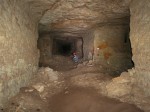 The necropolis was extensively reused starting in the 7th century B.C. as a cemetery for mummified animals. Between the 30th Dynasty (380-343 B.C.) and the Roman period, Saqqara was a major center of animal cult worship and networks of galleries were carved out of the rock of the plateau to house the mummified remains of huge numbers of cats, dogs, bulls, ibises, baboons and more. In 2011, archaeologists discovered an incredible eight million animal mummies, mostly dogs but some cats and mongooses as well, in a catacomb near the temple of Anubis just to the east of the Bubasteion.
The necropolis was extensively reused starting in the 7th century B.C. as a cemetery for mummified animals. Between the 30th Dynasty (380-343 B.C.) and the Roman period, Saqqara was a major center of animal cult worship and networks of galleries were carved out of the rock of the plateau to house the mummified remains of huge numbers of cats, dogs, bulls, ibises, baboons and more. In 2011, archaeologists discovered an incredible eight million animal mummies, mostly dogs but some cats and mongooses as well, in a catacomb near the temple of Anubis just to the east of the Bubasteion.
The area where Maia’s tomb was found is known as the Bubasteion, identified in Papyrus documents from the Late Period as the sanctuary of the cat goddess Bastet. Unlike the massive dog catacomb which was dug in the Late Period, the Bubasteion recycled the New Kingdom rock-cut tombs. Alain Zivie, then part of the French Archaeological Mission of Saqqara (FAMS), now director and founder of the French Archaeological Mission of the Bubasteion (MAFB) which has been excavating the necropolis since 1986, was the first to recognize in 1976 that the rock-cut tombs were originally created not for animals, but for important courtiers and high-ranking officials of 18th and 19th Dynasty Egypt.
The MAFB team has cleared more than a dozen tombs that were filled with debris and sand and whose original walls were obscured by Ptolemaic-era walls and pillars erected to support the rock ceilings which by then were in danger of imminent collapse. The new walls and pillars added in the conversion of the tombs to cat mummy catacombs helped preserve the original wall decorations — reliefs and paintings — and even hid some of the original burial gifts behind them. Maia’s tomb was full to the ceiling with sand, rubble and Ptolemaic modifications, which is why it has taken close to 20 years to fully excavate, clean and shore up the structure to make it safe for visitors.

